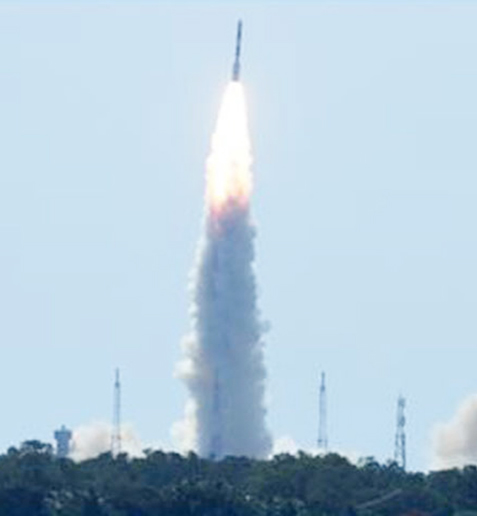
AFP, Seoul :
Nuclear-armed North Korea conducted two back-to-back tests of a powerful new medium-range missile on Wednesday, with both achieving a significant increase in flight distance over previous failed launches, South Korea’s Defence Ministry said.
Both tests were believed to be of a much-hyped, intermediate-range Musudan missile — theoretically capable of reaching US bases as far away as Guam.
International condemnation was swift, with the United States, NATO and Japan labelling the launches a clear violation of UN resolutions, and South Korea vowing to push for tighter sanctions on Pyongyang.
Existing UN Security Council measures ban North Korea from any use of ballistic missile technology.
The first test shortly before 6:00 am (2100 GMT Tuesday) was deemed to have failed after reportedly flying around 150 kilometres (90 miles) over the East Sea (Sea of Japan).
According to Japanese military monitors, the second missile attained a height of 1,000 kilometres and a range of 400 kilometres — a trajectory some experts suggested was calculated to avoid any violation of Japanese air space.
Four failed Musudan tests earlier this year all either exploded on the mobile launch pad or shortly after take-off.
A successful test would mark a major step forward for a weapons programme that ultimately aspires to develop a proven nuclear strike capability against the US mainland.
Melissa Hanham, an expert on North Korea’s WMD programme at the Middlebury Institute of International Studies in California, said Wednesday’s launches represented a worrying step forward.
“The second was likely a success. Testing is iterative and they are learning from each flight,” Hanham told AFP.
“Policymakers need to focus on a testing ban to prevent this from becoming a working missile,” she added.
US State Department spokesman John Kirby said the latest launches would only increase global efforts to counter North Korea’s illicit weapons programme.
“W?e intend to raise our concerns at the UN to bolster international resolve in holding (North Korea) accountable for these provocative actions,” Kirby said in a statement.
Japanese broadcaster NHK quoted Prime Minister Shinzo Abe as saying such tests “cannot be tolerated”, while NATO “strongly condemned” the launch in a statement from its secretary general.
South Korea’s foreign ministry warned that North Korea would face even stronger sanctions and said the tests underlined “the hypocrisy and deceptiveness” of Pyongyang’s recent offers of military talks with Seoul.
China, traditionally the North’s closest ally, cautioned against “any action that may escalate tension” and called for a resumed dialogue on the North’s nuclear programme.
First unveiled as an indigenous missile at a military parade in Pyongyang in October 2010, the Musudan has a theoretical range of anywhere between 2,500 and 4,000 kilometres.
Nuclear-armed North Korea conducted two back-to-back tests of a powerful new medium-range missile on Wednesday, with both achieving a significant increase in flight distance over previous failed launches, South Korea’s Defence Ministry said.
Both tests were believed to be of a much-hyped, intermediate-range Musudan missile — theoretically capable of reaching US bases as far away as Guam.
International condemnation was swift, with the United States, NATO and Japan labelling the launches a clear violation of UN resolutions, and South Korea vowing to push for tighter sanctions on Pyongyang.
Existing UN Security Council measures ban North Korea from any use of ballistic missile technology.
The first test shortly before 6:00 am (2100 GMT Tuesday) was deemed to have failed after reportedly flying around 150 kilometres (90 miles) over the East Sea (Sea of Japan).
According to Japanese military monitors, the second missile attained a height of 1,000 kilometres and a range of 400 kilometres — a trajectory some experts suggested was calculated to avoid any violation of Japanese air space.
Four failed Musudan tests earlier this year all either exploded on the mobile launch pad or shortly after take-off.
A successful test would mark a major step forward for a weapons programme that ultimately aspires to develop a proven nuclear strike capability against the US mainland.
Melissa Hanham, an expert on North Korea’s WMD programme at the Middlebury Institute of International Studies in California, said Wednesday’s launches represented a worrying step forward.
“The second was likely a success. Testing is iterative and they are learning from each flight,” Hanham told AFP.
“Policymakers need to focus on a testing ban to prevent this from becoming a working missile,” she added.
US State Department spokesman John Kirby said the latest launches would only increase global efforts to counter North Korea’s illicit weapons programme.
“W?e intend to raise our concerns at the UN to bolster international resolve in holding (North Korea) accountable for these provocative actions,” Kirby said in a statement.
Japanese broadcaster NHK quoted Prime Minister Shinzo Abe as saying such tests “cannot be tolerated”, while NATO “strongly condemned” the launch in a statement from its secretary general.
South Korea’s foreign ministry warned that North Korea would face even stronger sanctions and said the tests underlined “the hypocrisy and deceptiveness” of Pyongyang’s recent offers of military talks with Seoul.
China, traditionally the North’s closest ally, cautioned against “any action that may escalate tension” and called for a resumed dialogue on the North’s nuclear programme.
First unveiled as an indigenous missile at a military parade in Pyongyang in October 2010, the Musudan has a theoretical range of anywhere between 2,500 and 4,000 kilometres.

